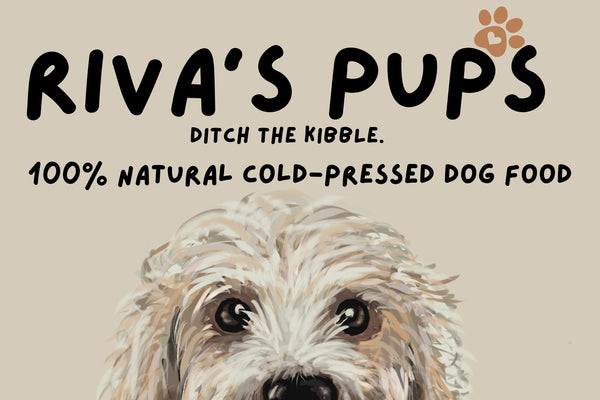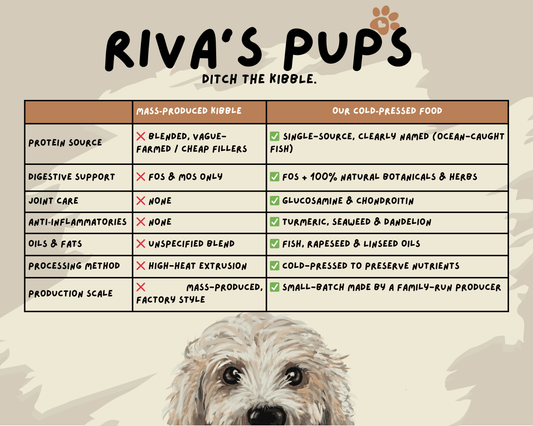
How to Read a Dog Food Label: A Free Guide for Pet Parents Who Want the Best
Share
How to Read a Dog Food Label: A Free Guide for Pet Parents Who Want the Best
If you've ever stood in the pet food aisle feeling overwhelmed by small print, percentages, and buzzwords—you’re not alone. But learning to read and truly understand a dog food label is one of the most powerful things you can do for your dog’s health.
This guide will help you decode ingredients, understand analytical percentages, and spot the difference between food made with genuine care—and food made by the tonne.
1. What Does the Ingredient List Really Tell You?
dog food ingredients are listed by weight before they’re cooked. So fresh meats might sit proudly at the top—but they’re mostly water. Once cooked, their protein contribution shrinks.
So what should you be looking for instead?
✅ Clearly named proteins – like ocean-caught fish (not mystery mixes “meat meals”)
🥕 Whole veg – think sweet potato, peas, carrot – not “derivatives”
🌿 Added goodness – herbs, turmeric, glucosamine, prebiotics… stuff that actually does something
2. Why Single-Source Protein Matters
Each of our cold-pressed recipes contains just one high-quality, clearly named protein—free-range chicken, ocean-caught fish, or responsibly sourced duck. That means 100% of the animal protein comes from one trusted source. No hidden extras. No shortcuts.
Now compare that to a typical mass-produced kibble label:
“Salmon & Trout 50% (Salmon & Trout 36%, Dried Salmon 12%, Salmon Stock 2%)”
Sounds premium, right? But take a closer look:
⚠️ That 50% includes a vague mix—fresh, dried, and stock forms of both salmon and trout
⚠️ There’s no breakdown of how much is actually premium salmon—it could be 18%, or even less
⚠️ Much of it is likely farmed, not wild, and there's no indication either way
⚠️ “Salmon” is the luxurious label ingredient, but the bulk could be cheap, farmed trout
💡 This lets brands splash “Salmon” across the front of the bag—even when it’s barely there.
Meanwhile, our food uses just one real, named meat—and it’s the good kind:
✅ Just free-range chicken
✅ Just ocean-caught fish (never farmed)
✅ Just duck from responsible sources
✅ No mystery blends
✅ No cheaper proteins snuck in
✅ Easier to digest and ideal for allergy-prone dogs
✅ And yes, it’s made from real meat—not scraps
3. What Are Analytical Constituents—and Why Should You Care?
This part of the label tells you the nutritional breakdown of what your dog is actually getting after the food is cooked. Think of it as the facts behind the marketing.
Here’s what each one means—and why it matters:
🥩 Protein – Builds muscle, supports the immune system, and keeps your dog strong. Look for 30% in a high-quality dry food (ours is 30% from real, named meat).
🧈 Fat – A key energy source and essential for brain development, skin health, and a shiny coat. Dogs need good fats, not just high amounts.That’s why we use only good fats—like real wild-caught fish oil, linseed, and rapeseed—rich in essential fatty acids. Fat isn’t just fuel; it’s a vital part of your dog’s wellbeing.
🌾 Fibre – Keeps digestion ticking along nicely. Too little can cause constipation; too much can block nutrient absorption.
🪨 Ash – The total mineral content. Not a bad thing! Higher ash from bones or seaweed is perfectly healthy—it’s about where it comes from, not just the number.
🦴 Calcium & Phosphorus – Critical for growing puppies and joint health in adults. They should always be in the right ratio (ours is 1.5% Ca : 1.0% P).
💧 Moisture – Dry foods usually sit around 8–10%. Cold-pressed food like ours often retains slightly more natural moisture, which can help with digestibility.
In short? Don’t just look at the front of the bag—this section tells you what’s really fuelling your dog’s body.
4. Cold‑Pressed vs Kibble: A Nutrient‑Preserving Choice
Most kibble is made via high‑heat extrusion, which can degrade nutrients and alter protein structures. It’s efficient—but not gentle.
Our food is cold‑pressed using low‑temperature compression. This preserves:
-
Natural vitamins
-
Protein structure
-
Healthy oils
The result? A meal that stays close to its whole-food origins—easy to digest and highly nutritious.
5. Dogs Are Omnivores—Complete Nutrition Matters
It’s a common misconception that dogs should eat like wolves. While their ancestors were primarily carnivores, domestic dogs have evolved over thousands of years—living alongside humans, scavenging, adapting, and thriving on a more varied diet. Dogs are omnivores, which means they need a balanced mix of:
-
High-quality protein
-
Vegetables and fruits
-
Essential fats
-
Vitamins, minerals, and antioxidants
We fully support the raw feeding community—done properly, it can be a fantastic way to nourish your dog. But let’s be honest: raw feeding isn’t always realistic for busy households.
👉 It requires:
-
Careful daily preparation
-
Strict hygiene practices
-
Detailed nutritional balancing
-
Consistent sourcing of multiple ingredients
Getting it wrong—even unintentionally—can lead to nutritional imbalances over time. That’s where we come in.
6. What’s in Our Bowl
Ocean Fish Cold‑Pressed Recipe
Ingredients:
Ocean‑Caught Fish (42%), Sweet Potato (27%), Potato (15%), Beet Pulp (5%), Peas (5%), Fish Oil, Carrot, Apple, Seaweed, Chicory Inulin, Fennel Seed, Sage, Thyme, Nettle, Oregano, Glucosamine, Chondroitin, Turmeric, Dandelion Root, Rapeseed Oil, Linseed Oil
Analytical Constituents:
-
Protein: 30%
-
Fat: 9%
-
Fibre: 3%
-
Ash: 8%
-
Moisture: 8.5%
-
Calcium: 1.5% • Phosphorus: 1.0%
-
Salt: 0.1% (no added salt)
-
Energy: 360 kcal / 100g
Nutritional Additives:
Full-spectrum vitamins (A, D3, E, C, B-complex, K) + Zinc, Copper, Manganese, Iron + functional joint support (Glucosamine & Chondroitin)
7. A Closer Look at Mass‑Made Kibble
Here’s the ingredient list from one of the UK’s largest dog food manufacturers—the same one producing for multiple smaller brands:
Ingredients:
Salmon & Trout 50% (36% fresh, 12% dried, 2% stock), Sweet Potato 24%, Peas 9%, Potato, Beet Pulp, Linseed, Omega 3 Supplement, Minerals, Asparagus 0.3%, FOS 96 mg, MOS 24 mg
Analytical Constituents:
-
Protein: 26%
-
Fat: 11%
-
Fibre: 3%
-
Ash: 7.5%
-
Moisture: 8%
-
Calcium: 1.4% • Phosphorus: 0.9%
-
Energy: 359 kcal / 100g
9. Thoughtfully Crafted vs Stripped‑Down Mass Production
We chose a different path—we partnered with a small, family-run, award-winning British manufacturer. Why? Because small-scale production means:
-
Fierce control over ingredients
-
Freedom to include delicate, beneficial extras
-
Care, repeatability, and craftsmanship in every batch
It’s not about volume—it’s about value for your dog.
10. What It All Means for Your Dog
Your pup deserves more than just calories. They deserve:
-
Transparent ingredients
-
Gut-supporting nutrition
-
Joint and inflammatory support
-
Oil-rich nourishment for skin and coat
-
Food that means something—bite after bite
We’ve thought about every ingredient, every process, and every benefit.
Want to Dig Deeper?
We're here to answer your questions. Curious about choosing the right recipe, elimination diets, or packing a trial bag? Get in touch—we're all about feeding confidence.



